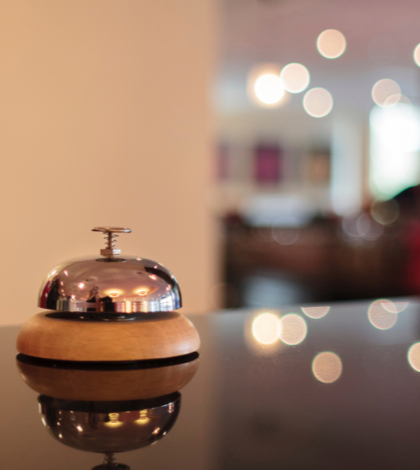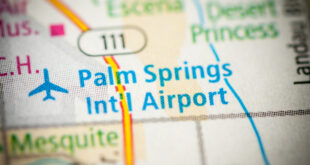Arrowhead Springs, once a destination for the likes of Humphrey Bogart and Marilyn Monroe, is on the market, and the city wants to get maximum use out of the site. It could be a resort again, but a mixed-use development sounds more likely.
It may be the best-kept secret in Southern California real estate: the Arrowhead Springs Hotel in San Bernardino, a former resort and getaway spot for Hollywood royalty that has been closed to the public for nearly 60 years.
Located about five miles north of downtown San Bernardino, the former hotel sits on 1,900-acres, 18 miles from Lake Arrowhead and surrounded on three sides by the San Bernardino National Forest.
Hot water bubbles up from a natural spring, an attraction that has drawn people to Arrowhead Springs since before the Civil War. The first building and spa, the ‘Hot Springs Infirmary,” was constructed there in 1864 by prospector David Noble Smith, who first visited the site in 1857.
Arrowhead Springs Hotel has undergone multiple renovations and expansions during the last 100 years. The most recent version, a 150-room facility designed by famed Los Angeles architect Paul Revere Williams, opened in 1939 and prospered until the mid-1950s.
Now the hotel and property are up for sale. Its owner, the interdenominational ministry formerly known as Campus Crusade for Christ, is asking about $50 million for the site, although the final price could be higher than that, said San Bernardino Councilman Fred Shorett.
That organization, now known as Cru, bought the hotel and property in 1962. It was the organization’s international headquarters, then became a conference center until the late 1990s, when Cru moved to Orlando, Fla., Shorett said.
Technically, the hotel and property have been on the market since Cru left. Only now, with the economy improving, has the ministry decided to make a push to sell both entities. It hopes to have a deal completed by the end of this year.
The ministry has enlisted Jones, Lang LaSalle, a Chicago-based commercial real estate and investment management firm, to market both entities. San Bernardino wrote a specific plan for the site and annexed the site – it was formerly an unincorporated part of San Bernardino County – to make a sale quicker and easier, Shorett said.
“This is potentially a huge economic boost for San Bernardino,” said Shorett, who represents the fourth ward, where Arrowhead Springs is located. “Being a religious organization, it was off the tax rolls all those years, but that’s about to change.”
Before it became a getaway spot for movie stars and other celebrities, Arrowhead Springs had a long and colorful history.
In 1874, Noble Smith sold the property to Robert Waterman, who later became governor of California. In 1893, a man named Seth Marshall built a Mission-style hotel there. That facility was a huge success until it burned down two years later.
By 1915, reservoirs had been built at Arrowhead Springs and the site was being serviced by railway. In 1925, an investment group bought the property and installed tennis courts, bungalows and a swimming pool, making Arrowhead Springs a full-fledged resort.
By 1930, Arrowhead Springs Hotel was one of the most popular resorts in the country; eight years later, it suffered another devastating fire and again burned to the ground. The former hotel that stands on the site now opened one year later.
At its peak, Arrowhead Springs hosted some of the most famous names in entertainment. Lucille Ball, Marilyn Monroe, Humphrey Bogart and Jerry Lewis all had bungalows there, and in 1950, Elizabeth Taylor honeymooned there with her first husband, hotel heir Conrad “Nicky” Hilton.
Two years later, Hilton bought the hotel and gave it a western theme, one of many makeovers the facility has undergone through the years.
But the hotel, which served as a Naval hospital for two years during World War II, fell off in popularity during the mid-1950s, when commercial air travel became more common and the rich and famous of Los Angeles could travel farther than San Bernardino for their leisure pursuits.
By 1956, when Fairmont Hotel Corp. owner Benjamin Swig bought the Arrowhead Springs Hotel from Hilton, the facility was losing $1,500 a day, according to a history of the property compiled by Jones Lang LaSalle.
While the location remains ideal – the site is within several miles of Interstate 10 and the Foothill Freeway and can also be reached via Highway 18 – the hotel is itself is out of date and needs another major overhaul, if it’s kept at all.
Among other things, the rooms are too small, and it’s not clear if the property would still work if it was only a resort, said Tom Turley, managing director with Jones Lang LaSalle.
“Based on infrastructure, this is probably not going to be an easy sale,” said Turley, who is seeking out potential buyers for the property and hotel. “But I don’t know of a another place like it, a resort that is so close to such a densely populated area. It’s only about a one-hour drive from Los Angeles, if there isn’t much traffic. It really is unique.”
Jones Lang LaSalle has received “five or six” offers for Arrowhead Springs, but no deal is being negotiated and the company is focusing on getting more bids, Turley said.
The company is taking two basic approaches when it pitches Arrowhead Springs to potential buyers: first, as a potential stand-alone resort, albeit one that would need major renovations to bring it up to modern standards.
If that doesn’t appeal to a potential suitor, Jones Lang LaSalle has a second approach: Arrowheads Spring could be remade into a mixed-use commercial development, a blend of residential and retail that could include a resort-hospitality component, perhaps even a golf course.
“There are a lot of things you could do with that property, but those have emerged as our Plan A and Plan B,” Turley said.
The specific calls allow for 1,350 residential units, which would be a mix of single-family estate homes, detached town homes, condominiums and a senior center. It also establishes 200,000 square feet for retail and restaurants, 200,000 square feet for a new 300-room hotel and 250,000 square feet for conference and office space.
Also, 200 acres are set aside for a public 18-hole golf course, and 1,400 acres for hiking and horseback trails.
The city likely will be willing to negotiate any of those guidelines with whoever buys the property.
“The specific plan is a flexible document,” Shorett said. “Some developer might want a golf course, another might not, but the plan allows for either way.”
 IE Business Daily Business news for the Inland Empire.
IE Business Daily Business news for the Inland Empire.


